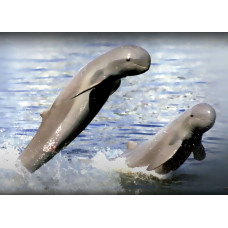Latin name
Orcaella brevirostris
Other names
Orcaella brevirostris
Identification
Unlike other members of the Delphinidae family, Irrawaddy dolphins lack a beak and have a flexible neck. The reason for this feature is the visible wrinkles behind the head. The head is convex, with the forehead extending over the mouth. The teeth are narrow, pointed, and about 1 cm long. Males tend to be larger, with longer dorsal fins. The Irawaddy's stomach is divided into compartments.
Features of fish fins
The pectoral fins are broad and triangular. The dorsal fins are also triangular and two-thirds the length of the body.
Sailing speed
The Irrawaddy dolphin swims slowly, but has been reported to swim at speeds of 20-25 kilometers per hour (12-16 mph) when chased by boats. In a year, females can sometimes swim an average of 45 kilometers, while males can swim an average of 100 kilometers.
Fish colouring
The coloration varies from gray-blue to bluish-gray, with a lighter coloration on the underside.
Distribution
Inhabits the coastal waters of the Indian Ocean from the Bay of Bengal to northern Australia. The population of these dolphins in Cambodia has been considered extinct since 2022.
Habitat
They inhabit brackish water near coasts, estuaries, and river mouths. They have formed subpopulations in freshwater rivers, including the Ganges and Mekong, and the Irrawaddy River, from which it takes its name.
Size
Weight 114-143 kg, height 146-275 cm.
Behavior
They live in groups of 3-6. They may move from one group to another. While exploring their territory, dolphins lift their heads out of the water and turn to see everything around them. When surfacing, only the top of the head is exposed to swallow air. Breathing is done very quickly and only 14% of dives are done with a splash.
A female or male dolphin will attempt to chase a mate for a few minutes. They will interlock face to belly and begin copulating for 40 seconds. Once copulation has occurred, the dolphins will separate and go in different directions.
The female or male dolphin will attempt to chase its mate for a few minutes. They then interlock face to belly and begin copulating for about 40 seconds. Once copulation is complete, the dolphins separate and disperse in different directions.
Food and feeding habits
These dolphins eat a wide variety of foods. These include fish, crustaceans and cephalopods.
While searching for food, pods of about 7 dolphins circle around the prey and catch it. These traps are just below the surface of the water. Food can be sucked into the mouth.
Reproduction
These dolphins are believed to reach sexual maturity between the ages of seven and nine. In the northern hemisphere, mating occurs from December to June. The gestation period is 14 months; females give birth to a calf every two to three years. Length at birth is about 1 m (3.3 ft). Birth weight is about 10 kg (22 lb). Weaning occurs at two years. Life expectancy is approximately 30 years.
Fishing
Have no commercial value. Most of the reported deaths of these dolphins are due to accidental capture and drowning in gillnets and, in the Philippines, bottom-set crab nets.
Relationship with a person
In Burma, in the upper Ayeyarwady River, dolphins drive fish toward fishermen using gillnets in response to acoustic signals from the fishermen. The fishermen try to attract the dolphins' attention in a variety of ways, including drumming with a cone-shaped wooden stick on the side of their canoes, banging their paddles on the surface of the water, rattling their nets, or making turkey-like cries. A pod of dolphins that agrees to work with the fisherman will surround a school of fish in a semicircle and guide it toward the boat. As a reward, the dolphins receive a portion of the fishermen's bycatch.
In several Asian countries, Irrawaddy dolphins have been captured and trained to perform in public aquariums.
| Classification | |
| Phylum | Chordata |
| Class | Mammalia |
| Squad | Artiodactyla |
| Family | Delphinidae |
| Genus | Orcaella |
| Species | O. brevirostris |
| Features | |
| Conservation status | Endangered |
| Habitat | Pelagic |
| Life span, years | 30 |
| Maximum body weight, kg | 143 |
| Maximum length, cm | 275 |
| Sailing speed, m/s | 6,94 |
| Threat to people | Edible |
| Way of eating | Predator |
Irrawaddy dolphin
Tags: irrawaddy dolphin



